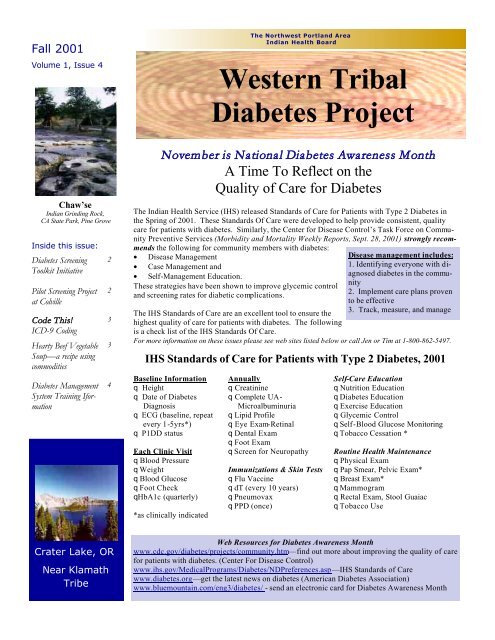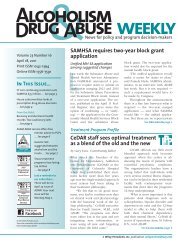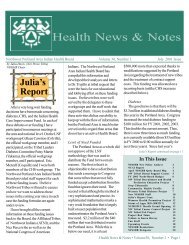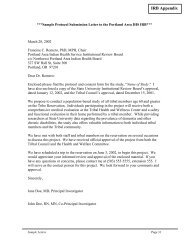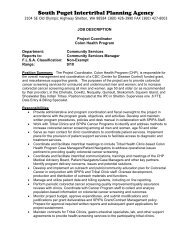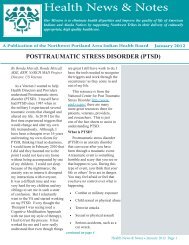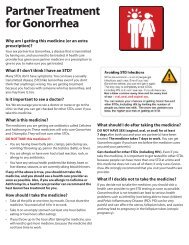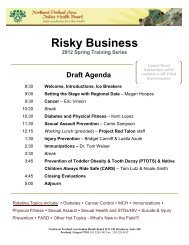Fall - Northwest Portland Area Indian Health Board
Fall - Northwest Portland Area Indian Health Board
Fall - Northwest Portland Area Indian Health Board
Create successful ePaper yourself
Turn your PDF publications into a flip-book with our unique Google optimized e-Paper software.
<strong>Fall</strong> 2001<br />
Volume 1, Issue 4<br />
The <strong>Northwest</strong> <strong>Portland</strong> <strong>Area</strong><br />
<strong>Indian</strong> <strong>Health</strong> <strong>Board</strong><br />
Western Tribal<br />
Diabetes Project<br />
Chaw’se<br />
<strong>Indian</strong> Grinding Rock,<br />
CA State Park, Pine Grove<br />
Inside this issue:<br />
Diabetes Screening<br />
Toolkit Initiative<br />
Pilot Screening Project<br />
at Colville<br />
Code This!<br />
ICD-9 Coding<br />
Hearty Beef Vegetable<br />
Soup—a recipe using<br />
commodities<br />
Diabetes Management<br />
System Training Iformation<br />
2<br />
2<br />
3<br />
3<br />
4<br />
November is National Diabetes Awareness Month<br />
A Time To Reflect on the<br />
Quality of Care for Diabetes<br />
The <strong>Indian</strong> <strong>Health</strong> Service (IHS) released Standards of Care for Patients with Type 2 Diabetes in<br />
the Spring of 2001. These Standards Of Care were developed to help provide consistent, quality<br />
care for patients with diabetes. Similarly, the Center for Disease Control’s Task Force on Community<br />
Preventive Services (Morbidity and Mortality Weekly Reports, Sept. 28, 2001) strongly recommends<br />
the following for community members with diabetes:<br />
• Disease Management<br />
• Case Management and<br />
• Self-Management Education.<br />
These strategies have been shown to improve glycemic control<br />
and screening rates for diabetic complications.<br />
Baseline Information<br />
q Height<br />
q Date of Diabetes<br />
Diagnosis<br />
q ECG (baseline, repeat<br />
every 1-5yrs*)<br />
q P1DD status<br />
Each Clinic Visit<br />
q Blood Pressure<br />
q Weight<br />
q Blood Glucose<br />
q Foot Check<br />
qHbA1c (quarterly)<br />
*as clinically indicated<br />
Annually<br />
q Creatinine<br />
q Complete UA-<br />
Microalbuminuria<br />
q Lipid Profile<br />
q Eye Exam-Retinal<br />
q Dental Exam<br />
q Foot Exam<br />
q Screen for Neuropathy<br />
Immunizations & Skin Tests<br />
q Flu Vaccine<br />
q dT (every 10 years)<br />
q Pneumovax<br />
q PPD (once)<br />
Disease management includes:<br />
1. Identifying everyone with diagnosed<br />
diabetes in the community<br />
2. Implement care plans proven<br />
to be effective<br />
3. Track, measure, and manage<br />
The IHS Standards of Care are an excellent tool to ensure the<br />
highest quality of care for patients with diabetes. The following<br />
is a check list of the IHS Standards Of Care.<br />
For more information on these issues please see web sites listed below or call Jen or Tim at 1-800-862-5497.<br />
IHS Standards of Care for Patients with Type 2 Diabetes, 2001<br />
Self-Care Education<br />
q Nutrition Education<br />
q Diabetes Education<br />
q Exercise Education<br />
q Glycemic Control<br />
q Self-Blood Glucose Monitoring<br />
q Tobacco Cessation *<br />
Routine <strong>Health</strong> Maintenance<br />
q Physical Exam<br />
q Pap Smear, Pelvic Exam*<br />
q Breast Exam*<br />
q Mammogram<br />
q Rectal Exam, Stool Guaiac<br />
q Tobacco Use<br />
Crater Lake, OR<br />
Near Klamath<br />
Tribe<br />
Web Resources for Diabetes Awareness Month<br />
www.cdc.gov/diabetes/projects/community.htm—find out more about improving the quality of care<br />
for patients with diabetes. (Center For Disease Control)<br />
www.ihs.gov/MedicalPrograms/Diabetes/NDPreferences.asp—IHS Standards of Care<br />
www.diabetes.org—get the latest news on diabetes (American Diabetes Association)<br />
www.bluemountain.com/eng3/diabetes/ - send an electronic card for Diabetes Awareness Month
Page 2 Volume 1, Issue 4<br />
Diabetes Screening Toolkit Initiative By Tim O’Hearn, MPH<br />
We need to develop a strategy for preventing diabetes – is a phrase being voiced by many tribes throughout<br />
the Pacific <strong>Northwest</strong>. In an effort to answer this need, the <strong>Indian</strong> <strong>Health</strong> Service (IHS), <strong>Portland</strong> <strong>Area</strong> Office and<br />
the <strong>Northwest</strong> <strong>Portland</strong> <strong>Area</strong> <strong>Indian</strong> <strong>Health</strong> <strong>Board</strong> (NPAIHB) and <strong>Northwest</strong> Tribes have collaborated to initiate and<br />
develop the <strong>Northwest</strong> <strong>Portland</strong> <strong>Area</strong> Diabetes Screening Toolkit (NPADST).<br />
The NPADST started in August 2001, and includes individuals from<br />
six tribal communities from the Pacific <strong>Northwest</strong> (Cow Creek,<br />
Quinault, Colville, Coquille, Coeur d’Alene & Warm Springs) In<br />
addition to answering community needs, the purpose of the toolkit<br />
includes:<br />
• Serving as a proactive approach in reducing the disparity of<br />
diabetes<br />
• Functioning as a comprehensive, community-based screening<br />
resource<br />
• Serving as standardization tool for community-based<br />
screening activities<br />
Components of the screening<br />
toolkit:<br />
• Screening target populations<br />
• Intervention strategies and examples<br />
• Diagnostic standards<br />
• Screening considerations<br />
• Institutional Review <strong>Board</strong> (IRB) issues<br />
• Managing screening data.<br />
The toolkit will be a screening resource for tribes in the <strong>Northwest</strong>. The expected completion and availability date for<br />
the toolkit is December 2001.<br />
The materials will include articles, web addresses relating to a particular topic or screening intervention. The toolkit<br />
will also provide information on the Institutional Review <strong>Board</strong> (IRB) issues, and provide its users a database training<br />
manual, as well as screening data base examples. The toolkit will take the form of a binder, professionally reviewed<br />
and complied. Additionally, as new screening information becomes available it will be added to the toolkit binder.<br />
For more information contact Tim O’Hearn at 1-800-862-5497.<br />
Pilot Screening Project at Colville<br />
October 2000<br />
Screening on the cutting edge...<br />
Once Colville’s diabetes program felt confident and competent<br />
in their care, attaining a 70% good control rate (HbA1c
Volume 1, Issue 4<br />
Page 3<br />
Code This! By James Oliver, RD<br />
It is extremely important to use the correct ICD-<br />
9 code. For diabetes diagnoses, these will be in<br />
the range 250.00-250.93. Within the code, the<br />
first three digits (250) refer to diabetes. The<br />
fourth digit (0-9) refers to complications (check<br />
the ICD-9 book for additional codes to use with<br />
complications). The fifth digit specifies type 1<br />
(odd) or type 2 (even). The fifth digit also indicates<br />
blood sugar control. Use a 2 (type 2) or 3<br />
(type 1) if uncontrolled; use a 0 (type 2) or 1<br />
(type 1) if not stated as uncontrolled. For example,<br />
if the purpose of visit (POV) states “DM<br />
type 2 uncontrolled”, use the code 250.02. If the<br />
POV states “Diabetes-hypoglycemia”, use either<br />
250.80 (if the patient is type 2) or 250.81 (if the<br />
patient is type 1).<br />
Try coding these real narratives from <strong>Indian</strong> Country<br />
providers:<br />
1. POV: “Diabetes mellitus type 2”<br />
2. POV: “Peripheral neuropathy secondary to DM”<br />
3. POV: “DM 2, insulin dependent, out of control”<br />
4. POV: “Diabetes screening”<br />
5. POV: “Acute bilateral DM”<br />
Answers:<br />
1. 250.00<br />
2. 250.60 (if type 2), 250.61 (if type 1)<br />
3. 250.02 (don’t be fooled by “insulin dependent”, this patient will<br />
always be type 2)<br />
4. V77.1 (always use this for screening)<br />
5. 382.9 (trick question: the POV was intended to say “Acute bilateral<br />
OM”, but the handwriting was difficult to read)<br />
Ingredients:<br />
1- 28 oz. can commodity beef<br />
2- 16 oz. can vegetarian beans<br />
2- 16 oz. can sliced carrots<br />
2- 16 oz. can whole kernel corn<br />
2- 16 oz. can green peas<br />
16 oz. can green beans<br />
16 oz. cans whole tomatoes, coarsely chopped<br />
Hearty Beef Vegetable Soup<br />
Makes about 24 one cup servings<br />
1 small onion, coarsely chopped<br />
2 celery stalks, coarsely chopped<br />
2 large red potatoes, coarsely chopped<br />
2 small cloves of garlic (or 1 teaspoon of garlic powder)<br />
8 cups water<br />
1 small package of fresh basil, chopped (or 2 tablespoons of<br />
Italian seasoning)<br />
½ package cooked pearl barley (it is easiest to cook this separately;<br />
follow the instructions on the package)<br />
Instructions:<br />
1. In a large pot, combine all ingredients except the basil and barley.<br />
2. Bring to a boil and simmer slowly for about 30 minutes,<br />
or until the red potatoes are tender.<br />
3. Stir in the cooked pearl barley and add black pepper to taste.<br />
4. Stir in the basil just before serving.<br />
Nutrition Facts<br />
Serving size: 1 cup<br />
Calories: 186<br />
Protein: 12.9 g.<br />
Carbohydrates: 21.4 g.<br />
Fat: 5.7 g.<br />
Saturated Fat: 2.1 g.<br />
Cholesterol: 28 mg<br />
Fiber:<br />
4.1 g<br />
Sodium:<br />
289 mg
The <strong>Northwest</strong> <strong>Portland</strong> <strong>Area</strong><br />
<strong>Indian</strong> <strong>Health</strong> <strong>Board</strong><br />
Western Tribal Diabetes Project<br />
527 SW Hall<br />
Suite 300<br />
<strong>Portland</strong>, OR 97201<br />
Phone: 800-862-5497<br />
Or 503-228-4185<br />
Fax: 503-228-4801<br />
W E’ RE ON THE WEB!<br />
WWW. NPAIHB. ORG<br />
The EpiCenter<br />
Diabetes Management System<br />
- Tribal Clinics moving forward<br />
with on-site<br />
Pitt River Staff and<br />
Dawn LaBlanc, <strong>Indian</strong> <strong>Health</strong> Service<br />
October 3rd, 2001<br />
Greenville Rancheria and Red Bluff Staff<br />
October 1st and 2nd, 2001<br />
Toiyabe <strong>Indian</strong> <strong>Health</strong> Project<br />
September 19th &20th, 2001<br />
To have an on-site<br />
training contact:<br />
California Region:<br />
Jen Olson<br />
1-800-862-5497<br />
jolson@npaihb.org<br />
<strong>Northwest</strong> (Idaho, Oregon, Washington)<br />
James Oliver<br />
1-800-862-5497<br />
joliver@npaihb.org<br />
Centralized Trainings:<br />
October 16-18, <strong>Northwest</strong> <strong>Portland</strong><br />
<strong>Area</strong> <strong>Indian</strong> <strong>Health</strong> <strong>Board</strong> (NPAIHB)<br />
December 11th, 12th & 13th,<br />
NPAIHB<br />
February 5th, 6th and 7th, Sacramento<br />
California Rural <strong>Indian</strong> <strong>Health</strong> <strong>Board</strong><br />
Others dates to be determined


